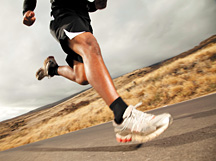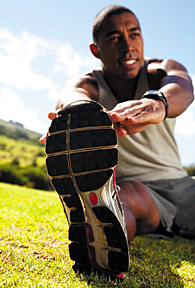Whether you are a pro athlete, a weekend warrior or just on your feet all day, shin splints can strike at any time, causing substantial pain. Fortunately, there are precautionary measures you can take to prevent painful shin splints from occurring and/or get you back to full health if you’re suffering from shin splints. Here’s an introduction to this common condition and information you should discuss with your doctor if you suspect you have shin splints.
What Are They?
Shin splints are muscle tears and hairline fractures in the anterior tibialis and tibia (shinbone). That’s the bone on the front of your lower leg. Shin splints are common to runners, basketball players, tennis players or anyone who is on their feet all day, such as grocery clerks, security officers, nurses, construction workers, etc.
The pain from shin splints can be mild or severe. Location of the pain varies according to which part of the lower leg structure has been damaged. If the tibia is red, hot and swollen, suspect a more severe injury than muscle damage to the lower leg.
Potential Causes
 Strength discrepancies can cause damage to the anterior leg. The anterior tibialis may be too weak to absorb impact .The calf may generate too much force for the muscles of the front of the leg to absorb impact when landing on a hard surface. Sometimes, inadequate padding in shoes can also cause problems to the lower leg.
Strength discrepancies can cause damage to the anterior leg. The anterior tibialis may be too weak to absorb impact .The calf may generate too much force for the muscles of the front of the leg to absorb impact when landing on a hard surface. Sometimes, inadequate padding in shoes can also cause problems to the lower leg.
From a biomechanical perspective, there are three types of “levers” in the body: first-, second- and third-class levers. When walking, the foot moves [pivots] via a second-class lever. The force is generated from the calf, the axis of rotation or pivot point, is the ball of the foot and the resistance goes down the middle of the body. A mechanical example would be a wheel barrow. The force is generated from the handles, the wheel is the pivot point and the resistance is in the middle of the wheel barrow.
The point is, if the body is not lined up correctly due to the spinal vertebrae being misaligned or muscles pulling the body off its center of balance, it may cause stress all the way down to the foundation of the body, which in this case would be the lower legs.
Treatment/Prevention Tips
Chiropractic: Shin splints are often brought about by improper biomechanics of the foot and knee or misalignment of the ankle, hip or spine. A chiropractic evaluation can assess biomechanical discrepancies of the spine, pelvis and ankles that may be contributing to the condition. Misalignment of the body can produce undue stress on the anterior compartment of the lower leg, causing shin splints to occur; chiropractic adjustments can help alleviate or prevent the condition.
Strength Training: Shin splints may be caused by the gastrocnemius [the calf] overpowering the tibialis anterior. When the calf muscles are tight, the anterior muscles [front muscles] of the leg are usually weak. Tight calves can cause anterior or frontal muscles to be overstretched. Overstretched muscles become weakened and inflamed. This is common in people who wear high-heeled shoes and/or don’t work out the front of their leg. Here are a few exercises to help prevent shin splints.
Sit on the edge of a high desk or table with your feet and legs hanging off the table. Secure a weight with a strap around the instep of the foot. (Note: Make sure you are on a high table so the weight hanging below your foot does not touch the floor.) Bring the toes up toward the front of the leg by bending the ankle up. You may also use a bungee cord in place of weights for resistance. Secure the bottom of the bungee cord to the floor and wrap the top of the bungee cord around the top of your foot; then lift your toes toward your leg by bending the ankle up. Perform this exercise 25 times, relax for 30 seconds, and then repeat 25 times for a total of 50 repetitions.
It is imperative to train the lower body with higher reps due to higher slow-twitch muscle fibers in the legs. Make sure to stretch the tight gastrocnemius muscles [calves] after warming up the muscle by walking for a few minutes. Stretch the muscle by keeping the involved leg back with the knee straight and heel on the floor. Slowly bend your front knee and lean onto wall until you feel the stretch in the calf. Hold for 30 seconds and repeat three times.
Cross the involved leg over the uninvolved leg. Pull your toes in the direction that will stretch the top of the leg away from the body. Hold for 30 seconds and repeat three times, three times a week. This protocol is used for balancing the weak muscles of the anterior [front] leg. Eventually, be sure to balance leg training by training the back of the leg [the calves and soleus muscles] To do this, you can perform seated calf raises and standing calf raises for one working set, 15-20 reps to failure, moving the weight slowly.
Place a 1-inch book or board under the front of the affected foot. Bend the nonaffected leg at the knee so that the nonaffected foot is off the ground. Hold on to a chair for added support. Push off the ball of the affected foot by lifting the heel off the ground. Perform this motion 25 times, relax 30 seconds, and then repeat 25 times, for a total of 50 repetitions. As the leg strengthens, increase the height of the book or board from 1 to 2 inches. Stretch the front and back of the lower leg at the end of the workout.
 For acute shin pain, rest for 48-72 hours, ice using a towel as a barrier on the skin three times a day for 20 minutes per application. If shin splints are chronic, alternate hot and cold applications: 10 minutes hot-towel application followed by 10 minutes cold-towel application, three times a day. The heat will cause vassal dilation and the cold will cause vassal constriction. Dilation and constriction create a pumping effect, aiding in circulation. Massage will help stretch the tight muscles in and around the shin and increase circulation, helping the healing process while relieving pain.
For acute shin pain, rest for 48-72 hours, ice using a towel as a barrier on the skin three times a day for 20 minutes per application. If shin splints are chronic, alternate hot and cold applications: 10 minutes hot-towel application followed by 10 minutes cold-towel application, three times a day. The heat will cause vassal dilation and the cold will cause vassal constriction. Dilation and constriction create a pumping effect, aiding in circulation. Massage will help stretch the tight muscles in and around the shin and increase circulation, helping the healing process while relieving pain.
Always talk to your doctor first if you suspect shin splints so they can diagnose the condition and make appropriate recommendations for treatment/care. There are also conditions that mimic shin splints, but may actually indicate more severe involvement of the shin and/or lower leg, so a qualified, comprehensive evaluation is always the first step.